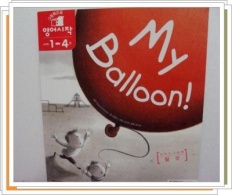The Louvre
Let's Visit the Louvre Museum
 루브르 박물관은 프랑스 파리에 있는 세계적인 미술관입니다.
루브르궁은 원래 역대 프랑스 국왕들이 거성으로 삼았던 곳으로 1200년 필립 오귀스트 왕이 성채를 축조하고 여기에 각종 무기나 고문서를 보관했으며, 그후로 프랑수아 1세, 루이 13새, 루이 14세 등이 방대한 양의 미술품을 수집해 소장했고, 프랑스 혁명 후 국민의회의 결정에 따라 소장하고 있는 미술품을 공개해 정식미술관으로 발족했고 일반인에게 공개되는 오늘날의 루브르 미술관에 이르게 됐다고 하네요.
저도 대학 3학년 때 파리의 명소인 루브르 박물관을 방문한 적이 있었지만 미술적, 역사적 지식을 충분히 갖고 있지 못했고, 워낙 많은 작품이 전시되어 있어서 기억에 남는 건 교과서를 통해 접해 본 적이 있는 한 두 작품뿐입니다.
게다가 박물관 내의 사진촬영은 거의 제한되어 있어서 엽서 몇 장에 박물관의 기억을 의존해야 하지요.
언제가 아이와 함께 손을 잡고 예술의 도시에 자리잡고 있는 루브르 박물관을 관람할 날을 기약하며 이 책을 통해 박물관에 대한 예비지식을 쌓고 박물관에 전시된 작품을 감상해보시기 바랍니다.
투명필름지가 주는 특수효과 덕택에 아이도 지루하지 않게 예술품을 눈여겨보게 될 거예요.
여기를 눌러 루브르 박물관 공식 홈페이지도 잊지말고 방문해보세요.
진귀한 물건들로 가득 찬, 출입구가 피라미드 모양인 이 커다란 건물은 뭘까요?
파리에 있는 루브르 박물관입니다.
< 샤를르 5세 때의 루브르>
프랑스 국왕 필립 오귀스트는 1200년 루브르를 건설하기 시작했습니다.
1360년 샤를르 5세는 요새를 하나의 성으로 만들었습니다.
(확장공사를 해 성을 건물들로 둘러쌓지요.)
프랑수와 1세, 앙리 4세, 루이 14세 등 프랑스 국왕들은 루브르 성을 증축해 확장해나가고, 예술 작품들로 채우기 시작했습니다.
여기를 누르셔서 Pol de Limbourg의 'The Louvre of Charles Ⅴ'를 감상하세요.
여기로 가시면 루브르의 연혁을 살펴볼 수 있습니다.
수천 년 전에 이집트인들은 죽은 사람을 보존했습니다.
각각의 미라를 석관에 두었습니다.
< 청동 거울>
< 콜 단지>
여러분은 루브르 박물관에서 Imeneminet 석관을 볼 수 있습니다.
루브르박물관 공식 홈페이지(http://www.louvre.fr/louvrea.htm)에 가셔서 'collections'에 있는 'Egyptian antiquities'에 있는 이집트 고 미술품을 감상해보세요.
이 두 마리의 황소(상) 각각에는 수염이 난 남자의 머리가 있습니다.
황소는 아시리아 궁전의 입구를 지키곤 했습니다.
정면에서 보면 황소상의 다리가 두 개입니다.
측면에서 보면, 다리가 네 개입니다.
그리고 어떤 각도에서 보면 다리가 다섯 개지요.
여기를 누르시면 'Winged Assyrian bull '(Khorsabad, palaceof Sargon of Assyria)를 보실 수 있어요.
한 그리스 도예가가 여자의 머리와 남자의 머리를 한데 모아...
이 화병을 만들었습니다.
이것은 기원전 6세기 당시의 예술의 일부입니다.
이 도예가는 점토로 화병을 만듭니다.
그리고는 흙과 식물로 만든 염료로 칠을 합니다.
화병은 가마에서 단단하게 구워집니다.
이 훌륭한 비너스상 (Venus de Milo) 은 수세기에 걸쳐 전해 내려오고 있습니다.
하지만 비너스상은 팔을 잃었습니다.
팔이 없어도 여전히 아름답네요.
여기를 눌러 'Venus de Milo'을 감상하세요.
레오나르도 다 빈치가 리사 게라르디니(Elisabetta Gherardini)의 초상화를 그렸을 때, 리사 부인은 이 그림이 세상에서 가장 유명한 그림 중 하나가 될지도 모른다고 생각했습니다.
이 작품이 바로 '모나리자'입니다.
***'모나리자'는 레오나르도 다 빈치가 피렌체의 부호(富豪) 프란체스코 델 조콘다를 위해 그 부인인 엘리자베타(Elisabetta)를 그린 초상화로 모나리자의 '모나'는 이탈리아어로 유부녀에 대한 경칭이고 '리자'는 엘리자베타의 약칭이라고 합니다. 또, 조 콘다부인은 피렌체의 안토니오 마리아 디 놀드 게라르디니(Gherardini)의 딸이라는군요.
여기를 눌러 'Mona Lisa'보세요.
자, 이제 루브르 박물관에 있는 수많은(방대한) 명작 중 몇 가지를 살펴보지요.
'Statue of Ebih-Il '- 메소포타미아
기원전 2500년 경, 대리석
여기를 누르세요.
'The archers of Darius'- 이란, '활소는 사람'을 조각 한 다리우스 궁전의 소벽(小壁).
여기를 누르세요.
'Seated scribe' - 이집트 , 기원전 2700-2200, 채색된 석회암
여기를 누르면 보실 수 있습니다.
'Model boat'- 이집트, 채색된 나무
'Torso of and athlete' -그리스, 대리석
여기를 눌러보세요.
'The Victory of Samothrace'- 그리스, 대리석
여기를 누르세요.
*** Samothrace는 'island in the North Aegean Sea'
'Marriage sarcrophagus'- Etruscan Italy, 테라코타
여기를 눌러보세요.
'Old man and boy' -Domenico Ghirlandaio(이탈리아인), 목판에 그린 유화
여기를 누르세요.
'Money-lender and wife' - Quetin Metsys(네델란드인), 목판에 그린 유화
여기를 눌러 그림을 감상하세요.
'Philippe Pot's tomb'- Antoine Le Moiturier, 석재
여기를 누르세요.
'Dying slave'- Michelangelo, 대리석
여기를 눌러 미켈란젤로의 작품을 감상하세요.
'St Joseph the Carpenter'- Georges de La Tour(프랑스인), 캔버스 유화
여기를 누르세요.
'The Lacemaker'- Jan Vermeer(네델란드인)
여기를 누르세요.
'Horse from Marly'- Guillaume Coustou, 석재
여기를 눌러 보세요.
'Liberty Guiding the People'- Eugene Delacroix(프랑스인), 캔버스 유화
여기를 눌러 작품을 감상하세요.
루브르의 건물들과 정원들은 파리 중심부에 위치하고 있습니다.
프랑스 국왕들은 궁전을 짓기에 (정말) 좋은 장소를 선택했지요.
튈르리 정원/ 카루셀 개선문/ 피라미드 출입구/ 세느강/
mummy : 미라(처럼 생긴 것)
a dead body which was preserved long ago by being rubbed with special oils and wrapped in cloth.
sarcophagus : 석관
a large decorative coffin that was used in ancient times.
charm : 팔찌·쇠사슬 등에 달아 몸에 지니는 장식품.
a small ornament that is fixed to a bracelet or necklace.
kohl: 아라비아 등의 여성이 눈까풀 등을 검게 칠하는 데 쓰는 가루.
a cosmetic used to darken the edge of a person's eyelids
kiln: (벽돌 등을 굽는) 가마, 노(爐).
an oven that is used to bake pottery, bricks, and timber in order to make them become hard.
scribe : (인쇄술 발명 전에 사본을 베껴쓰던) 사본 필경자
a person who wrote copies of things such as letters or documents.
Etruscan: 에트루리아의, 에트루리아인[어, 문명]의.
terracotta : 원래는 구운 흙을 뜻하지만 양질의 점토로 구워낸 토기류를 지칭하기도 함
a brownish-red clay that has been baked but not glazed and that is used for making things such as flower pots, small statues, and tiles.
It's a glassy Pyramid, a main entrance of the Louvre museum
Francis had 'this fortress of Philip Augustus'(old castle) razed and built the Louvre of today.( 양쪽 그림의 Louvre가 다른 이유는 부수고 다시 지었기 때문이란 사실을 알려주세요.)
They are stone bulls with human heads
Seen from the front they are motionless.
But when they are seen from the side, they walk
The style is characteristic of the late Hellenistic period,
Mona Lisa is among the most widely popular and influential paintings.
Her smile in the picture is mysterious, isn't it?
Do you see the archers in ceremonial dress?
This work of art is made out of glazed brick.
This 'Seated scribe' with sharp eyes looks intelligent .
'Torso of an athlete'shows a standing, nude male figure
'Tomb of Philippe pot' is a funerary monument made out of painted stone.
Michelangelo's Slave is best known sculpture in the Louvre.
Michelangelo made two Slaves in marble unfinished .
두산세계대백과 EnCyber
http://www.eb.com/limited_search.html
Collins Colbuild English Dictionary
http://members.tripod.lycos.co.kr/dennisworld
http://www.artcyclopedia.com/
http://louvre.pe.kr/
루브르 박물관은 프랑스 파리에 있는 세계적인 미술관입니다.
루브르궁은 원래 역대 프랑스 국왕들이 거성으로 삼았던 곳으로 1200년 필립 오귀스트 왕이 성채를 축조하고 여기에 각종 무기나 고문서를 보관했으며, 그후로 프랑수아 1세, 루이 13새, 루이 14세 등이 방대한 양의 미술품을 수집해 소장했고, 프랑스 혁명 후 국민의회의 결정에 따라 소장하고 있는 미술품을 공개해 정식미술관으로 발족했고 일반인에게 공개되는 오늘날의 루브르 미술관에 이르게 됐다고 하네요.
저도 대학 3학년 때 파리의 명소인 루브르 박물관을 방문한 적이 있었지만 미술적, 역사적 지식을 충분히 갖고 있지 못했고, 워낙 많은 작품이 전시되어 있어서 기억에 남는 건 교과서를 통해 접해 본 적이 있는 한 두 작품뿐입니다.
게다가 박물관 내의 사진촬영은 거의 제한되어 있어서 엽서 몇 장에 박물관의 기억을 의존해야 하지요.
언제가 아이와 함께 손을 잡고 예술의 도시에 자리잡고 있는 루브르 박물관을 관람할 날을 기약하며 이 책을 통해 박물관에 대한 예비지식을 쌓고 박물관에 전시된 작품을 감상해보시기 바랍니다.
투명필름지가 주는 특수효과 덕택에 아이도 지루하지 않게 예술품을 눈여겨보게 될 거예요.
여기를 눌러 루브르 박물관 공식 홈페이지도 잊지말고 방문해보세요.
진귀한 물건들로 가득 찬, 출입구가 피라미드 모양인 이 커다란 건물은 뭘까요?
파리에 있는 루브르 박물관입니다.
< 샤를르 5세 때의 루브르>
프랑스 국왕 필립 오귀스트는 1200년 루브르를 건설하기 시작했습니다.
1360년 샤를르 5세는 요새를 하나의 성으로 만들었습니다.
(확장공사를 해 성을 건물들로 둘러쌓지요.)
프랑수와 1세, 앙리 4세, 루이 14세 등 프랑스 국왕들은 루브르 성을 증축해 확장해나가고, 예술 작품들로 채우기 시작했습니다.
여기를 누르셔서 Pol de Limbourg의 'The Louvre of Charles Ⅴ'를 감상하세요.
여기로 가시면 루브르의 연혁을 살펴볼 수 있습니다.
수천 년 전에 이집트인들은 죽은 사람을 보존했습니다.
각각의 미라를 석관에 두었습니다.
< 청동 거울>
< 콜 단지>
여러분은 루브르 박물관에서 Imeneminet 석관을 볼 수 있습니다.
루브르박물관 공식 홈페이지(http://www.louvre.fr/louvrea.htm)에 가셔서 'collections'에 있는 'Egyptian antiquities'에 있는 이집트 고 미술품을 감상해보세요.
이 두 마리의 황소(상) 각각에는 수염이 난 남자의 머리가 있습니다.
황소는 아시리아 궁전의 입구를 지키곤 했습니다.
정면에서 보면 황소상의 다리가 두 개입니다.
측면에서 보면, 다리가 네 개입니다.
그리고 어떤 각도에서 보면 다리가 다섯 개지요.
여기를 누르시면 'Winged Assyrian bull '(Khorsabad, palaceof Sargon of Assyria)를 보실 수 있어요.
한 그리스 도예가가 여자의 머리와 남자의 머리를 한데 모아...
이 화병을 만들었습니다.
이것은 기원전 6세기 당시의 예술의 일부입니다.
이 도예가는 점토로 화병을 만듭니다.
그리고는 흙과 식물로 만든 염료로 칠을 합니다.
화병은 가마에서 단단하게 구워집니다.
이 훌륭한 비너스상 (Venus de Milo) 은 수세기에 걸쳐 전해 내려오고 있습니다.
하지만 비너스상은 팔을 잃었습니다.
팔이 없어도 여전히 아름답네요.
여기를 눌러 'Venus de Milo'을 감상하세요.
레오나르도 다 빈치가 리사 게라르디니(Elisabetta Gherardini)의 초상화를 그렸을 때, 리사 부인은 이 그림이 세상에서 가장 유명한 그림 중 하나가 될지도 모른다고 생각했습니다.
이 작품이 바로 '모나리자'입니다.
***'모나리자'는 레오나르도 다 빈치가 피렌체의 부호(富豪) 프란체스코 델 조콘다를 위해 그 부인인 엘리자베타(Elisabetta)를 그린 초상화로 모나리자의 '모나'는 이탈리아어로 유부녀에 대한 경칭이고 '리자'는 엘리자베타의 약칭이라고 합니다. 또, 조 콘다부인은 피렌체의 안토니오 마리아 디 놀드 게라르디니(Gherardini)의 딸이라는군요.
여기를 눌러 'Mona Lisa'보세요.
자, 이제 루브르 박물관에 있는 수많은(방대한) 명작 중 몇 가지를 살펴보지요.
'Statue of Ebih-Il '- 메소포타미아
기원전 2500년 경, 대리석
여기를 누르세요.
'The archers of Darius'- 이란, '활소는 사람'을 조각 한 다리우스 궁전의 소벽(小壁).
여기를 누르세요.
'Seated scribe' - 이집트 , 기원전 2700-2200, 채색된 석회암
여기를 누르면 보실 수 있습니다.
'Model boat'- 이집트, 채색된 나무
'Torso of and athlete' -그리스, 대리석
여기를 눌러보세요.
'The Victory of Samothrace'- 그리스, 대리석
여기를 누르세요.
*** Samothrace는 'island in the North Aegean Sea'
'Marriage sarcrophagus'- Etruscan Italy, 테라코타
여기를 눌러보세요.
'Old man and boy' -Domenico Ghirlandaio(이탈리아인), 목판에 그린 유화
여기를 누르세요.
'Money-lender and wife' - Quetin Metsys(네델란드인), 목판에 그린 유화
여기를 눌러 그림을 감상하세요.
'Philippe Pot's tomb'- Antoine Le Moiturier, 석재
여기를 누르세요.
'Dying slave'- Michelangelo, 대리석
여기를 눌러 미켈란젤로의 작품을 감상하세요.
'St Joseph the Carpenter'- Georges de La Tour(프랑스인), 캔버스 유화
여기를 누르세요.
'The Lacemaker'- Jan Vermeer(네델란드인)
여기를 누르세요.
'Horse from Marly'- Guillaume Coustou, 석재
여기를 눌러 보세요.
'Liberty Guiding the People'- Eugene Delacroix(프랑스인), 캔버스 유화
여기를 눌러 작품을 감상하세요.
루브르의 건물들과 정원들은 파리 중심부에 위치하고 있습니다.
프랑스 국왕들은 궁전을 짓기에 (정말) 좋은 장소를 선택했지요.
튈르리 정원/ 카루셀 개선문/ 피라미드 출입구/ 세느강/
mummy : 미라(처럼 생긴 것)
a dead body which was preserved long ago by being rubbed with special oils and wrapped in cloth.
sarcophagus : 석관
a large decorative coffin that was used in ancient times.
charm : 팔찌·쇠사슬 등에 달아 몸에 지니는 장식품.
a small ornament that is fixed to a bracelet or necklace.
kohl: 아라비아 등의 여성이 눈까풀 등을 검게 칠하는 데 쓰는 가루.
a cosmetic used to darken the edge of a person's eyelids
kiln: (벽돌 등을 굽는) 가마, 노(爐).
an oven that is used to bake pottery, bricks, and timber in order to make them become hard.
scribe : (인쇄술 발명 전에 사본을 베껴쓰던) 사본 필경자
a person who wrote copies of things such as letters or documents.
Etruscan: 에트루리아의, 에트루리아인[어, 문명]의.
terracotta : 원래는 구운 흙을 뜻하지만 양질의 점토로 구워낸 토기류를 지칭하기도 함
a brownish-red clay that has been baked but not glazed and that is used for making things such as flower pots, small statues, and tiles.
It's a glassy Pyramid, a main entrance of the Louvre museum
Francis had 'this fortress of Philip Augustus'(old castle) razed and built the Louvre of today.( 양쪽 그림의 Louvre가 다른 이유는 부수고 다시 지었기 때문이란 사실을 알려주세요.)
They are stone bulls with human heads
Seen from the front they are motionless.
But when they are seen from the side, they walk
The style is characteristic of the late Hellenistic period,
Mona Lisa is among the most widely popular and influential paintings.
Her smile in the picture is mysterious, isn't it?
Do you see the archers in ceremonial dress?
This work of art is made out of glazed brick.
This 'Seated scribe' with sharp eyes looks intelligent .
'Torso of an athlete'shows a standing, nude male figure
'Tomb of Philippe pot' is a funerary monument made out of painted stone.
Michelangelo's Slave is best known sculpture in the Louvre.
Michelangelo made two Slaves in marble unfinished .
두산세계대백과 EnCyber
http://www.eb.com/limited_search.html
Collins Colbuild English Dictionary
http://members.tripod.lycos.co.kr/dennisworld
http://www.artcyclopedia.com/
http://louvre.pe.kr/
쑥쑥 플러스
컨텐츠
-

 [영어편지]Kipper에게
[영어편지]Kipper에게
- 마루맘
- |
- 2009-07-16
-

 [영어편지]백설공주를 사랑한 소년
[영어편지]백설공주를 사랑한 소년
- 마루맘
- |
- 2009-07-13
-
 [영어편지]스파이더맨에게
[영어편지]스파이더맨에게
- kbmom
- |
- 2009-07-13
-
 [영어편지]Kitty에게
[영어편지]Kitty에게
- kbmom
- |
- 2009-07-13
-
 [영어편지]울아들 첫편지-To mom
[영어편지]울아들 첫편지-To mom
- 재키맘
- |
- 2009-07-13
-
 [영어편지]바쿠간에게 쓰는 편지
[영어편지]바쿠간에게 쓰는 편지
- 준맘
- |
- 2009-07-07
-
 [공지]09년 제 2차 컨텐츠공모전 수상자 8명 발표
[공지]09년 제 2차 컨텐츠공모전 수상자 8명 발표
- 운영자
- |
- 2009-06-29
-
 스스로! 스스로! 스스로!(8)
스스로! 스스로! 스스로!(8)
- 령돌맘
- |
- 2009-06-26
-
리딩의 팁
- 가오리
- |
- 2009-06-26
-
 웬디 제야의 리딩/리스닝 스토리
웬디 제야의 리딩/리스닝 스토리
- 웬디제야맘
- |
- 2009-06-26
-
 토깽이가 좋아하는 짧은 그림책
토깽이가 좋아하는 짧은 그림책
- 꽁이
- |
- 2009-06-25
-
 예원이 리딩이야기3- 공룡
예원이 리딩이야기3- 공룡
- 하양맘
- |
- 2009-06-24


 쑥쑥몰
쑥쑥몰
 체험이벤트
체험이벤트














